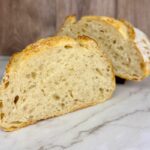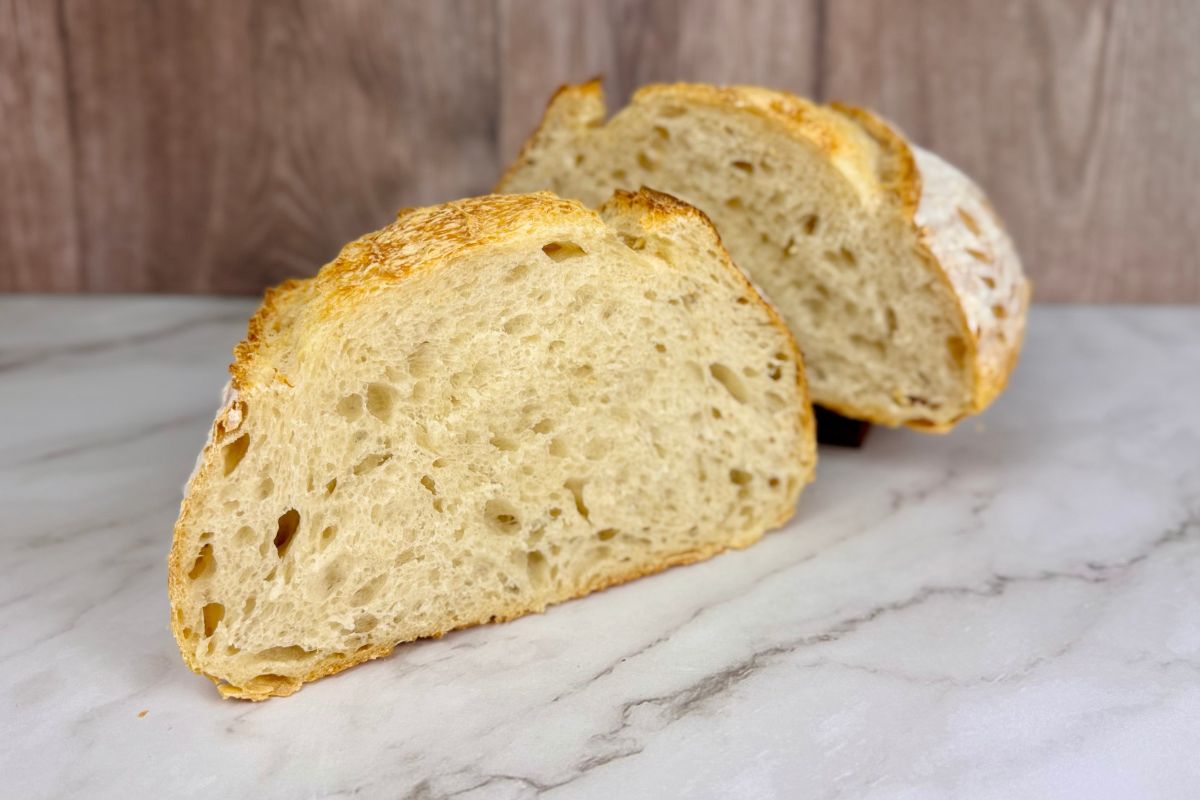Sourdough bread is more than just a delicious loaf—it's a labor of love that connects you to centuries of baking tradition. With its signature tangy flavor, chewy crust, and airy crumb, sourdough bread is a delight to eat and deeply satisfying to make. Whether you’re a seasoned baker or just beginning your bread-making journey, this guide will walk you through crafting artisan sourdough bread from start to finish.
Print


Artisan Sourdough Bread Recipes
- Total Time: 24 hours 45 minutes
Ingredients
Units
Scale
- 125g Active Sourdough Starter
- 350g Filtered Water
- 500g Unbleached Bread Flour
- 10g Salt
Instructions
- Mix active sourdough starter and filtered water until milky
- Add unbleached bread flour and salt. Mix with a wooden spoon or dough whisk until combined. Scrape down the sides and bottom of the bowl with a plastic bench scraper. Mix with hands until well combined and the dough has a shaggy consistency. Cover and let dough rest for 30 minutes.
STRETCH & FOLDS
- Grab a portion of your dough, pull up & gently stretch the dough (do not tear, only stretch as far as it lets you) fold dough over top. Turn your bowl a 1/4 turn and repeat until dough will not stretch anymore and is a tight ball shape.
- Cover and let dough rest for 30-45 minutes until dough relaxes.
- Repeat previous step 3 times.
BULK FERMENTATION
- Leave your dough covered in a warm place until it rises 30-35% more than what is already in the dough. BF times vary depending on the temperature and humidity of your environment. BF can take anywhere from 2-8 hours. Your dough should have bubbles on the top and along the edge. It should pull away from the sides of the bowl easily.
- I recommend you use a glass bowl and use the same bowl every time. This will allow you to see what your dough is doing and how much it has risen. With a little trial and error and practice you will learn where that perfect spot is on your bowl to stop BF and shape your dough.
SHAPING/LAMINATING/STITCHING
- Let your dough self-release out of the bowl. Do not pull or tear your dough.
- Pick your dough up from the middle and let the sides fall under. Do this a few times until your dough forms a ball.
- Now do some push and pulls to create tension in the dough. Place your hand, palm side against the dough, behind the dough ball. Push the dough forward 5-6 inches and then turn the ball with your hand in the shape of a candy cane. Your hand should be on the opposite side of the dough ball. Pull back and tuck the dough under the ball. Repeat this motion until the dough ball feels like a hard-boiled egg (Do not tear the top surface of the dough, this will release the tension).
- Cover with a towel and let rest for 30-45 minutes
- Final shaping, do push and pulls again until dough feels like a hard-boiled egg.
- Dust banneton lightly with flour and place dough top side down in the basket. Let rest for 15 minutes.
- Grap a small piece of dough from the edge and gently pull to the middle. Hold it with your other hand. Repeat this step around the entire perimeter of the dough. Hold in the center for 20-30 seconds until it sticks and stays.
- Cover dough with a disposable bowl cover or place in a shopping bag and tie it.
COLD FERMENTATION
- Place your dough in the refrigerator. It is recommended to cold ferment for 8-48 hours. I usually cold ferment overnight.
PRE-HEATING THE OVEN
- Preheat oven to 450 degrees for 45-60 minutes with the dutch or bread oven inside. Place a pizza stone or cookie sheet on the rack below. This will help distribute the heat evenly and keep the bottom of your bread from getting over cooked.
SCORING
- Place your dough onto a large piece of parchment paper. Dust with flour.
- This is where you can get creative. Do a decorative wheat design by lightly scoring the surface.
- Cut a deeper control score across the top or along the side of the dough, roughly a ¼ inch deep and at a 45-degree angle. This allows the steam that is created in your dough to escape. Without the deep score your dough will burst open at its weakest point. The control score also helps with create a great oven spring.
BAKING
- Place your dough on the parchment paper into the Dutch oven and place the cover on top.
- Bake for 30 minutes with the lid on and then remove the lid and bake for 15 minutes with the lid off. Internal temperature should be 200 degrees.
- Remove the bread from the Dutch oven and place on a cooling rack. Remove parchment paper while the bread is hot.
- Let cool for a minimum of 1-2 hours before cutting into it. If you cut the bread while it is hot the inside will be gummy.
EAT & ENJOY!
- Prep Time: 24 hours
- Cook Time: 45 minutes
- Category: Sourdough Bread
- Method: Oven-Baked


